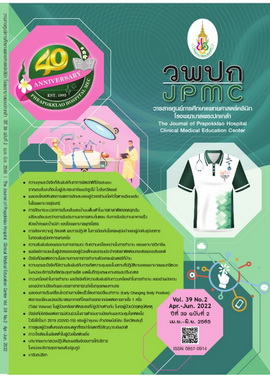Prevalence of Hand-arm Vibration Syndrome and Related Factors among Carpenters in Phrae Province, Thailand
Main Article Content
Abstract
BACKGROUND: Prolonged occupational exposure to vibration has been associated with clinical disorders of vascular, neurological, and musculoskeletal systems known as the hand-arm vibration syndrome (HAVS).
OBJECTIVE: The aim of this study was to determine the prevalence of HAVS and the associated factors among carpenters in Phrae Province, Thailand.
METHOD: This cross-sectional study consisted of 236 carpenters employed in wood processing plants. A stratified sampling technique was applied. The data were collected by using a questionnaire and monofilament testing and analyzed by using descriptive statistics and binary logistic regression.
RESULTS: The overall prevalence of HAVs was 74.2%. The prevalence of musculoskeletal, vascular, and neurological disorders was 60.6%, 36.4%, and 16.7%, respectively. Factors associated with HAVs were the pushing hand posture, gender, age, current smoking, continuously working more than 20 minutes, and length of exposure time (year).
CONCLUSION: With this high prevalence of HAVs, anti-vibration gloves should be provided. The avoidance of pushing hand posture, more break time, and job rotation should also be applied. Moreover, a health promotion program, especially smoking cessation program, should be launched.
Article Details

This work is licensed under a Creative Commons Attribution-NonCommercial-NoDerivatives 4.0 International License.
References
Qamruddin AA, Nik Husain NR, Sidek MY, Hanafi MH, Ripin ZM, Ali N. Prevalence of hand-arm vibration syndrome among tyre shop workers in Kelantan, Malaysia. J Occup Health 2019 ;61:498-507.
Sutinen P, Toppila E, Starck J, Brammer A, Zou J, Pyykkö I. Hand-arm vibration syndrome with use of anti-vibration chain saws: 19-year follow-up study of forestry workers. Int Arch Occup Environ Health 2006;79:665-71.
Ishitake T, Ando H. Significance of finger coldness in hand-arm vibration syndrome. Environ Health Prev Med 2005;10:371-5.
Su AT, Darus A, Bulgiba A, Maeda S, Miyashita K. The clinical features of hand-arm vibration syndrome in a warm environment--a review of the literature. J Occup Health 2012;54:349-60.
Tekavec E, Löfqvist L, Larsson A, Fisk K, Riddar J, Nilsson T, et al. Adverse health manifestations in the hands of vibration exposed carpenters – a cross sectional study. J Occup Med Toxicol 2021;16:16.
Aarhus L, Stranden E, Nordby KC, Einarsdottir E, Olsen R, Ruud B, et al. Vascular component of hand-arm vibration syndrome: a 22-year follow-up study. Occup Med (Lond) 2018;68:384-90.
Mbutshu LH, Malonga KF, Ngatu NR, Kanbara S, Longo-Mbenza B, Suganuma N. Incidence and predictors of hand-arm musculoskeletal complaints among vibration-exposed African cassava and corn millers. Saf Health Work 2014;5(3):131-5.
Edlund M, Burström L, Gerhardsson L, Lundström R, Nilsson T, Sandén H, et al. A prospective cohort study investigating an exposure-response relationship among vibration-exposed male workers with numbness of the hands. Scand J Work Environ Health 2014;40:203-9.
Zhang W, Wang Q, Xu Z, Xu H, Li H, Dong J, et al. An experimental study of the influence of hand-arm posture and grip force on the mechanical iiImpedance of hand-arm system. Shock and Vibration[Internet] 2021[cited 2021 Nov 11]; 2021: 9967278. Available from: https://downloads.hindawi.com/journals/sv/2021/9967278.pdf

